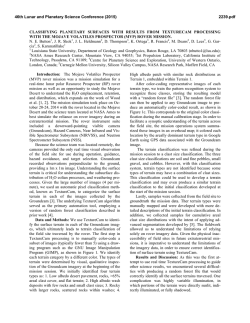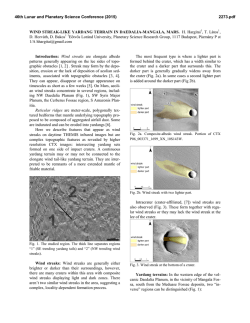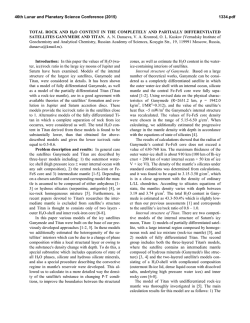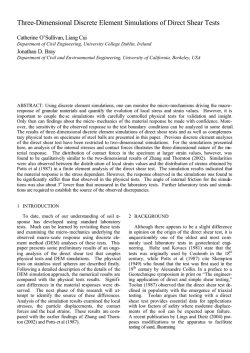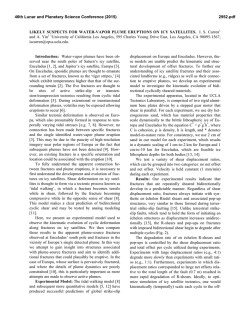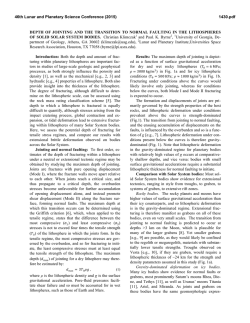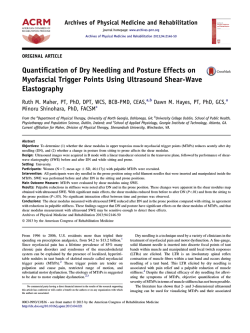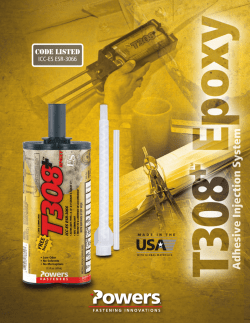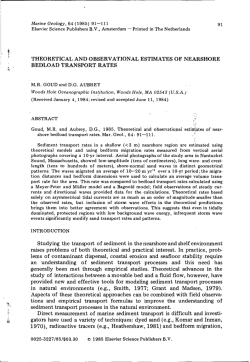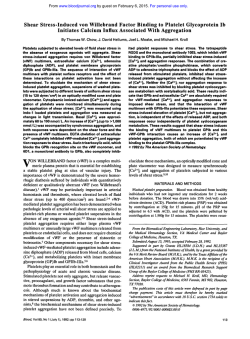
GLOBAL MORPHOLOGICAL MAPPING OF STRIKE-SLIP
46th Lunar and Planetary Science Conference (2015) 2985.pdf GLOBAL MORPHOLOGICAL MAPPING OF STRIKE-SLIP STRUCTURES ON GANYMEDE. F. Seifert1,2, M.E. Cameron3, B. R. Smith-Konter3, R.T. Pappalardo2, and G. C. Collins4, 1University of Michigan, Atmospheric Oceanic and Space Sciences Department, [email protected], 2Jet Propulsion Laboratory California Institute of Technology, [email protected],3 University of Hawaii at Manoa, Department of Geology and Geophysics, [email protected], [email protected], 4 Wheaton College, Physics and Astronomy Department, [email protected]. Introduction: Many inferences of strike-slip faulting and distributed shear zones on Ganymede suggest that strike-slip tectonism may be important to the structural development of its surface and in the transition from dark to light (grooved) materials. Several fundamental questions have emerged and motivate this study: Is there an evolutionary sequence of strike-slip structures on Ganymede? What role may this play in the transition from dark material to grooved terrain? What are the faulting conditions (stress magnitudes, fault depths, ice friction) that permit strike-slip faulting? To better understand the role of strike-slip tectonism in shaping Ganymede’s multifaceted surface, we first identify and map key examples of strike-slip morphologies (en echelon structures, strike-slip duplexes, laterally offset pre-existing features, and possible strained craters) from Galileo and Voyager images. This identification is performed at a global scale, with detailed mapping performed as relevant to facilitate structural interpretation. Next, we assess first-order stress orientations derived from global stress models to investigate shear failure mechanisms and faulting conditions. Here we present the current state of these global mapping and modeling efforts with particular emphasis given to complex structures associated with grooved terrain of the Nun Sulci region (imaged during Galileo’s G7 orbit), and the Galileo Transitional Terrain observation (imaged during the G2 orbit) of a region transitional from dark terrain of Marius Regio to light terrain of Nippur Sulcus. Summary of Results: Nun Sulci. The Nun Sulci region displays complexly intersecting lanes of grooved terrain and has been previously hypothesized to display evidence of strike-slip displacement [1,2,3]. We observe two dominant tectonic domains of similar morphology at Nun Sulci (Figure 1): NW-SE oriented lanes (units 1-3) underlying E-W oriented bands (units 4-7). Right-lateral offset is observed at Nefertum crater [4] (label a), possible left-lateral offset (labels bc) is inferred along units 2 and 3, and several regions of echelon structures (labels d-f) are observed throughtout the region. Based on these observations, we infer two stages of deformation for grooved terrain at Nun Sulci. For stage 1 (units 1-3), we infer E-W extension, perhaps accompanied by some right-lateral shearing. For stage 2, we infer left-lateral shearing of E-W oriented bands (units 4-7), and reactivation of extensional fractures (units 1-3) that introduce right-lateral antithetic shear fractures (labels g,h). Transitional Terrain. The “Transitional Terrain” is a region where dark terrain has been converted to bright terrain, with fault duplex formation likely associated with strike-slip motion [2,3]. From our mapping efforts of the Transitional Terrain region [Figure 2], we infer left-lateral shearing along the prominent NW-SE grooved lanes (represented by units 1 and 2), consistent with associated normal faulting in the light terrain (unit 3), structural orientations in the dark terrain (unit 4), and inferred counterclockwise rotation of the central fault duplex (unit 5) . Faults bounding the duplex show trends similar to those in dark terrain, suggesting inheritance of structural trends. Shear Failure Modeling. Assuming tidal diurnal & non-synchronous rotation (NSR) stresses as plausible mechanisms for strike-slip tectonism, we investigate the mechanics of Coulomb shear failure in these and other regions of Ganymede. To calculate tidal stresses on Ganymede, we utilize numerical code SatStress [5,6]. Our results suggest right-lateral shear stress, consistent with observed offset. In the Dardanus Sulcus region, shear failure is possible down to depths of 2 km assuming a low coefficient of friction (µf = 0.2) along the fault, while failure is limited to about 1 km depth for a high coefficient of friction (µf = 0.6). Conclusions: Preliminary work suggests that strike-slip tectonism may be important to the transition of dark to light materials and that tidal stresses can be sufficient to induce shear failure and generate strikeslip offset. Ongoing work will expand mapping to two additional regions of high resolution imagry Philus/Nippur and Arbela. These additional maps will alow a greater understanding of these processes. These results are being synthesized into a global database representing an inferred sense of shear for fractures on Ganymede. This, combined with existing observations of extensional features, is helping to narrow down the range of possible principal stress directions that could have acted at the regional or global scale to produce 46th Lunar and Planetary Science Conference (2015) 2985.pdf Nun Sulci e g 4 h 1 f d 2 5 3 a 6 c b 7 3’ 2’ Transitional Terrain 4 1 3 5 4 2 100 km Figure 1: Top-Structural map of the Nun Sulci region of Ganymede, imaged during Galileo orbit G7, with units 1-7 and features a-m labeled here and discussed in more detail in the text. labeled Bottom- Structural map of the Transitional Terrain region, imaged during Galileo’s G2 orbit, with units/features 1-5 labeled here and discussed in more detail in the text. grooved terrain. Moreover, these data sets, combined with mechanical models of shear failure and global stress sources, are providing constraints for testing possible mechanisms for grooved terrain formation on Ganymede. References: [1] S. Murchie and J.W. Head (1988) JGR 93, 8795-8824; [2] G. Collins et al. (1998) LPSC XXIX, Abstract #1755. [3] R.T. Pappalardo et al. (1997) LPSC XXVIII, Abstract #1231. [4] R.T. Pappalardo and G. Collins (2005) J. Struct. Geol. 27, pp. 827-838. [5] Wahr, J. et al. (2009) Icarus, 200, 188- 206; [6] Cameron, M. et al. (2013) LPSC XLIV, Abstract # 2711. Additional Information: This research was funded under NASA OPR Award 12-OPR12-0105. Government Sponsorship Acknowleged
© Copyright 2025
